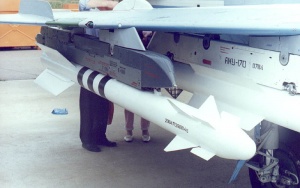R-73
Contents
Description
Write an introduction to the article in 2-3 small paragraphs. Briefly tell us about the history of the development and combat using the weaponry and also about its features. Compile a list of air, ground, or naval vehicles that feature this weapon system in the game.
Vehicles equipped with this weapon
General info
Tell us about the tactical and technical characteristics of the missile.
Effective damage
Describe the type of damage produced by this type of missile (high explosive, splash damage, etc)
Comparison with analogues
Give a comparative description of missiles that have firepower equal to this weapon.
Usage in battles
Describe situations when you would utilise this missile in-game (vehicle, pillbox, base, etc)
Pros and cons
Summarise and briefly evaluate the weaponry in terms of its characteristics and combat effectiveness. Mark pros and cons as a list.
Pros:
Cons:
History
After seeing advances in western development of short-range IR missiles during the early 1970s, such as the AIM-9L (and later the AIM-9M, which entered service one year before the R-73) and their success in combat, primarily the Sidewinder in Middle Eastern conflicts arming Israeli aircraft, and also seeing the shortcomings (primarily range and flare resistance) of their own "Dogfight missiles" in the form of the R-60 and R-60M, the Soviet Union set out to develop and deploy a new class of missile, which would combine the advantages of both the Dogfight missiles such as the SRAAM and R-60s, while maintaining the advantageous capabilities of contemporary short-range missiles, such as the AIM-9 Sidewinder and R-13M.
Under a directive from the Soviet government, development began in 1973 by Vympel OKB to create a new generation of all-aspect "Kill on sight" missile, called Izdeliye 730 (Project 730). The "Kill on sight" missile was to incorporate the best of both worlds of missile designs, such as the high manoeuvrability and instantaneous "off the rail" tracking of the older dogfight missiles such as the R-60 and R-60M, while also including the reliable range and tracking of short range missile designs like the R-13M and the prototype all-aspect R-14 missile (which would be later cancelled in favour of the R-73). Unfortunately, by design principle, the missile either had to be large with a long burning motor to attain acceptable ranges, or small and lightweight to be manoeuvrable like a dogfight missile at the cost of range. The R-73 would be the first air-to-air missile to use a hybrid control system, utilizing not only thrust vectoring capability to attain high angles of attack and instantaneous manoeuvring, similar to older western projects (AIM-95 and SRAAM, both of which failed), but also utilized more conventional aerodynamic controls through fins and destabilizers to retain control even after the motor shuts down. This design allowed the missile to not only retain its "Dogfight missile" manoeuvrability (even improving it over older designs like the R-60M), but also allowed it to be larger in size, enough to fit more fuel and a stronger motor to attain similar ranges to contemporary missiles of the time, such as the AIM-9L. The second aspect of the "Kill on sight" missile doctrine was the helmet-mounted targeting system, which was developed in parallel to the R-73. This system would allow the missile's seeker to be targeted at "High off-boresight" without having to manoeuvre the aircraft to position the target inside the missile's seeker, providing a massive advantage in a dogfight over contemporary missiles. Almost an entire decade of development later, Project 730 would finally be completed in 1982, entering trials almost immediately as the R-73 missile.[1]
After trials, the missile would enter service in 1984, and receive the NATO reporting name AA-11 Archer, and shortly after, a export variant (R-73E) would be produced and sold to most allies of the USSR operating their new MiG-29 fighters. The R-73 would go on to become a staple of Soviet (and later Russian) missile design, with the USSR and later the Russian Federation upgrading it into many new variants to modify and/or improve its performance, starting with the R-73L and ending most recently with the R-74M1.
In 1990, when Germany was re-unified, the Luftwaffe found itself with a lot of leftover ex-East German MiG-29 aircraft, and alongside them, their stockpiles of R-73 missiles. In 1994, a dissimilar air combat training between USAF F-16As of the 510th Fighter Squadron and Luftwaffe MiG-29s took place in a NATO airbase in Aviano, Italy. After an overwhelming victory from the German MiG-29s, utilizing the R-73 and their helmet-cued targeting, the USA and the rest of the NATO countries realized that they had underestimated the R-73's capabilities, and found that it had better manoeuvrability, tracking, and seeker acquisition than the contemporary NATO missiles at the time (AIM-9L and AIM-9M)[2], which prompted the US and NATO countries to develop their own advanced contemporaries, namely the AIM-9X, AIM-132 ASRAAM, IRIS-T, and the MICA Infrarouge.
Media
Excellent additions to the article would be video guides, screenshots from the game, and photos.
See also
Links to the articles on the War Thunder Wiki that you think will be useful for the reader, for example:
- reference to the article about the variant of the weapon;
- references to approximate analogues by other nations and research trees.
External links
Paste links to sources and external resources, such as:
- topic on the official game forum;
- other literature.




